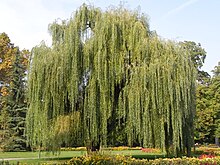Habit (biology)



Habit in biology is about the shape or behaviour of animals and plants.
Botany
[change | change source]The way plants grow makes their shape of habit. This is the way we can tell trees apart even at a distance. The shape of a willow tree or a poplar is very distinct. It is made during growth. Bacteria and fungi also have very distinct types of growth.
Trees are also examples of a life style when compared to shrubs and annual plants. To be a tree is to occupy a different space in the ecosystem from shrubs or climbers.
Zoology
[change | change source]In zoology, habit often refers to a specific behaviour of a species. For example:
- ...the [cat] was in the habit of springing upon the [door knocker] in order to gain admission...[1]
- The spider monkey has an arboreal habit and rarely ventures onto the forest floor.
- The brittlestar has the habit of breaking off arms as a means of defence.
The 'mode of life' (or 'lifestyle') is sometimes referred to as the 'habit of an animal. Terms like motile or sessile, sedentary, free-living, parasitic, saprophyte, terrestrial, arboreal, aquatic, pelagic, diurnal, nocturnal, are all modes of life or habits.
References
[change | change source]- ↑ William Chambers; Robert Chambers (1835). Chambers's Edinburgh Journal. W. Orr. pp. 69–.
